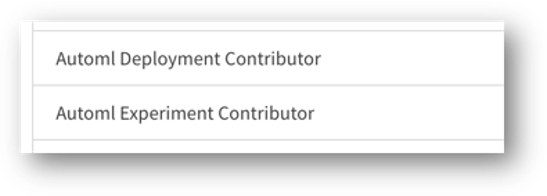Predictive AI – Continued Innovation in AutoML
Automated free text feature engineering uses sophisticated algorithms under the hood to allows far better prediction from free text fields. This complements the date feature engineering capability that Qlik™ released last year, which automatically parses dates into usable features.
Organizations now have role-based access control for AutoML users. Qlik™ has added two new user roles to support AutoML – experiment contributors and deployment contributors, which can be assigned to specific users or groups. With this, you can now control and limit access to AutoML to the right types of users.
You now get SHAP (explainability) data for multiclass problems. Prior to this, SHAP data was not available for these types of models, but now you can generate and download explainability data in the same manner as binary classification and regression-based models.
Also, you can now change the data set for existing experiments. Users can now more easily iterate and refine experiments without having to create a new experiment when changing features or retraining models with new data sets.
Qlik™ has improved the performance of the real-time connector. Real-time integration of predictive models within analytics apps supports associative exploration and what-if analysis. With this update, Qlik™ has revised the architecture to improve speed and better support real-time production workloads.
As noted in Qlik™’s 2024 industry trends – Hybrid AI Bridges the Maturity Gap, it’s critical to take a portfolio approach to AI – one that leverages both generative and predictive AI to solve a full breadth of problems. According to the Boston Consulting Group, generative AI is only expected to achieve ~30% share of the overall AI market by 2024. So, in two years’ time traditional machine learning will still represent the majority of the AI market. And there’s a reason for this – because traditional ML delivers highly actionable, accurate predictions for specific use-cases that can drive improved outcomes across your business and tremendous value.
With Qlik™ AutoML, machine learning can be available to more than just professional data scientists. Your analytics users and teams can now become citizen data scientists and generate predictions in a simple and effective way for the “other 90% of use cases” not covered by data scientists – areas such as sales forecasting, churn reduction, customer acquisition, inventory optimization, spend analysis, etc. Qlik™ offers a simple yet powerful, code-free ML workflow with AI-assistance and unlimited experimentation. Predictions are delivered with full explanations so you can see not just what might happen, but why. You can also easily publish predictions or integrate models into Qlik Sense™ for real-time associative exploration and what-if scenario planning.
A number of enhancements have recently been made to Qlik™ AutoML that will add even more value for customers and prospects looking to democratize the power of predictive AI. With these improvements you get more advanced feature engineering and explainability, better control over users and roles, more iterative experimentation, and improved performance. With these improvements you get more advanced feature engineering and explainability, better control over users and roles, more iterative experimentation, and improved performance.
Specifically:
- Automated free text feature engineering has been added, allowing far better prediction from free text fields. Under the hood we’re using advanced techniques to look for signal within free text strings, generating 10’s of thousands of possible features which are automatically evaluated for importance and used for prediction. All this is invisible to the user, but you’ll notice text fields will have much better predictive influence. This complements the date feature engineering capability that was released last year, which automatically parses dates into usable features.
- Organizations now have role-based access control for AutoML users. Two new user roles have been added to support AutoML – experiment contributors and implementation contributors, which can be assigned to specific users or groups. With this, you can now control and limit access to AutoML to the right types of users.
- You now get SHAP (explainability) data for multiclass problems. Prior to this, SHAP data was not available for these types of models, but now you can generate and download explainability data in the same manner as binary classification and regression-based models.
- You can now change the data set for existing experiments. Users can now more easily iterate and refine experiments without having to create a new experiment when changing features or retraining models. You can now re-use the same experiments, with the same version history and settings, when changing features in the data set or loading new sets of records. This means you can more easily test new features in an iterative manner, and refresh models with new historical data if business conditions have changed.
- Real-time connector performance has been improved. Real-time integration of predictive models within analytics apps supports associative exploration and what-if analysis. With this update, we’ve revised the architecture to improve speed and better support real-time production workloads.
For a brief presentation, please watch the videoclip below.
For information about Qlik™, please visit this site: qlik.com.
For specific and specialized solutions from QQinfo, please visit this page: QQsolutions.
In order to be in touch with the latest news in the field, unique solutions explained, but also with our personal perspectives regarding the world of management, data and analytics, we recommend the QQblog !


